Are you looking to add a new houseplant to your indoor garden but want to be sure it has huge leaves to match existing plants? If so, you’ve arrived at the ideal location! This post delves deeper into our top big-leafed plants, which look great in almost any interior setting!
1. Fiddle Leaf Fig

Scientific Name: Ficus lyrata
Plant Type: Broadleaf evergreen
Plant size: 10 feet tall
Sun needs: Bright, indirect light
Water needs: Maintain moderate moisture
The well-known Fiddle Leaf Fig is a great option if you’re looking for an indoor plant with large leaves. The leaves on this tree are fiddle-shaped, waxy, and green.
The notoriously finicky nature of fiddle-leaf fig trees calls for a skilled and careful hand. They are from the rainforest and can only survive in environments with extreme heat and humidity. For the typical plant owner, it can be challenging to accomplish that in their house.
Owners of fiddle-leaf fig trees frequently encounter discoloration and leaf drops as a result of inadequate environmental conditions. To prevent subjecting them to sharp temperature swings, it is advisable to keep them away from vents and air conditioners.
2. Kentia Palm

Scientific Name: Howea forsteriana
Plant type: Perennial palm
Plant size: 12 feet tall
Sun needs: Bright, indirect light
Water needs: Up to maturity, keep the moisture level constant and even
The kentia palm is a low-maintenance, effortlessly grown houseplant. They can withstand droughts and yield deep green, arching fronds that resemble palms. They add a touch of old-world grandeur to a space and look lovely in a sunny corner.
Additionally, kentia palms can adjust to their surroundings. They are not very picky about soil and may thrive in a variety of lighting situations. It should be shielded from bright light so as not to scorch the foliage.
Potassium deficits and pests like mealybugs and spider mites are common problems with kentia palms.
3. Ruffled Fan Palm

Scientific Name: Licuala Grandis
Plant Type: Perennial palm
Plant size: 6 feet tall
Sun needs: Partial to complete shade
Water needs: If the top inch of soil becomes dry, provide water
The Ruffled Fan Palm boasts amazing heart-shaped foliage with paper-fan-like folds. These leaves have sharp edges, and the palm of the leaf has spines in some places. When fully grown, though, the leaves sprout from a single trunk and reach a width of up to 22 inches.
They are a popular interior house plant due to their distinctive appearance, although they can be challenging to obtain. Plant owners who seek pet-safe solutions for their homes also lust for them.
4. Swiss Cheese Plant

Scientific Name: Monstera adansonii
Plant type: Climbing evergreen
Plant size: 10 to 12 feet high and 3 feet wide
Sun needs: Bright, indirect light
Water needs: When the top inch of soil is dry, provide water
The Swiss Cheese Plant is linked to the Monstera. It also yields big, fenestrated leaves that are bright green in colour. When given the right support in its container, this variety grows like a vine, and instead of splitting its leaves, it forms holes in them.
When houseplants are cultivated indoors, Swiss cheese plants grow quickly but do not get very tall. For them to flourish, constant fertilizer and pruning are necessary.
5. Velvet Philodendron
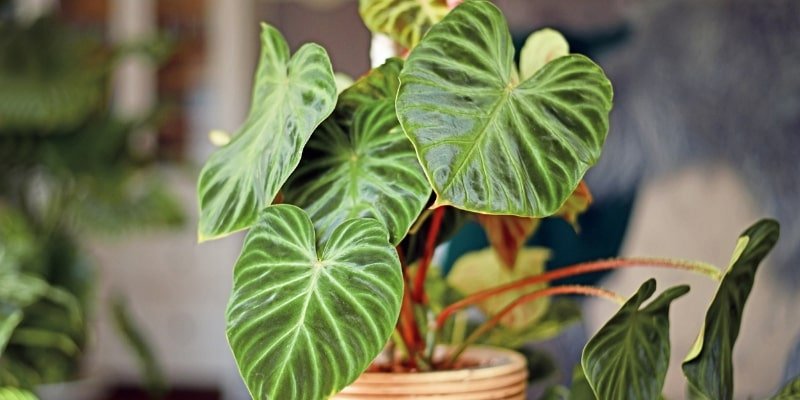
Scientific Name: Philodendron gloriosum
Plant Type: Evergreen perennial
Plant size: 3 feet tall
Sun needs: Bright, indirect light
Water needs: Maintain even moisture
A unique creeping philodendron native to Colombia is called the velvet philodendron. Huge, heart-shaped leaves with a yellow-green hue. Each leaf has exquisite veins that run the length of them in shades of pink, pale green, or cream.
If you are unable to attain 60–80% humidity in your home, you should mist your velvet philodendrons frequently. The plant yields one new leaf per month and grows slowly.
6. African Mask Plant
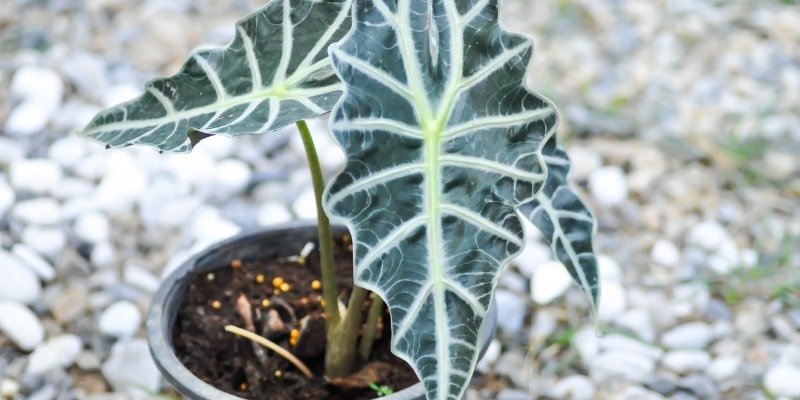
Scientific Name: Alocasia Amazonica
Plant type: Herbaceous perennial
Plant size: 6-7 feet high and 10 inches broad
Sun needs: Bright, indirect light
Water needs: Every 6-7 days
The African Mask Plant is one of the most striking indoor houseplants. It is a tiny plant with huge, heart-shaped, dark green leaves that have wavy edges. Every waxy leaf has a purple underside with extensive white veining.
Growing an African mask plant indoors might be challenging, but if you succeed, you’ll be rewarded with a stunning plant. To prevent burning the leaves, you should keep them out of direct sunlight and ensure humid conditions.
7. Cast-Iron Plant
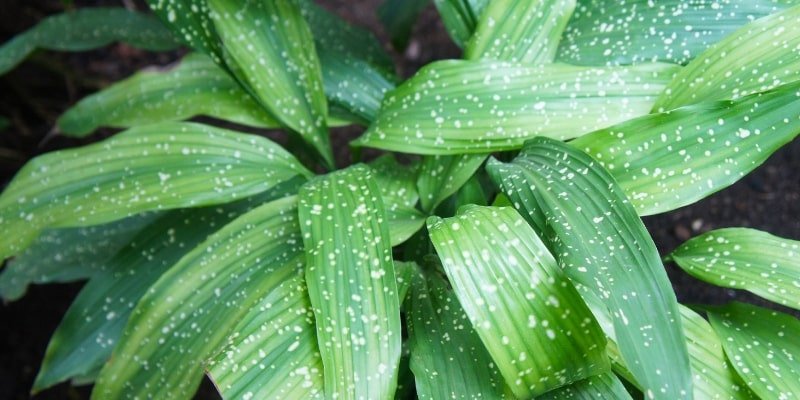
Scientific Name: Aspidistra elatior
Plant type: Herbaceous perennial
Plant size: 3 feet high and 2 feet broad
Sun needs: Indirect sun, partial shade
Water needs: When the soil’s top inch is dry, apply water
One of the most popular houseplants that are almost impossible to destroy is the cast-iron plant. It can withstand low light levels and thrives on neglect. Additionally, it develops tall, arching, two-foot-long leaves that are deep green in colour.
Beginners or someone with a famously bad thumb will love cast-iron plants. They are not just low-maintenance but also resistant to many common illnesses and pests.
8. Leopard Plant

Scientific Name: Farfugium japonicum
Plant Type: Evergreen perennial
Plant size: 4 feet high and 3 feet broad
Sun needs: Partial sun to full shade
Water needs: Maintain even and consistent moisture
When grown inside, leopard plants offer gorgeous, spherical, glossy leaves. Belonging to the sunflower family is this plant. The leopard plant yields gorgeous yellow flowers that are highly attractive to pollinators when it grows under ideal conditions.
Certain kinds give the plant its name by having vivid yellow dots on their leaves. Their preference for soil type is inconsequential; nonetheless, to prevent wilting and leaf drop, they need regular, even watering. They should not be near draughty windows or air conditioning vents, and they also need warmer temperatures.
9. Elephant Ear
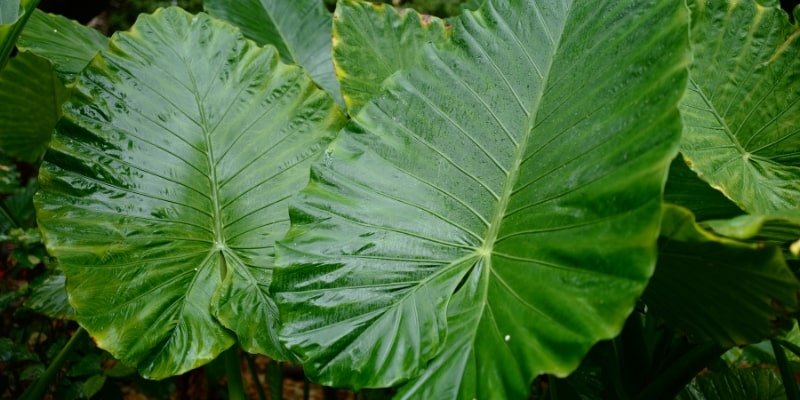
Scientific Name: Colocasia
Plant type: Ornamental, tropical
Plant size: 8 feet high and 6 feet broad
Sun needs: Bright, indirect light
Water needs: 2-3 inches per week
The huge, arrowhead-shaped leaves of elephant ear plants are the source of their name. There are several kinds available, with only minor differences in the colour and shape of the leaves. The majority are blue-green in hue.
Elephant ears are simple to grow and care for, but they can get rather tall. Although they thrive in indoor containers, they are usually cultivated outdoors. Elephant ears are heavy eaters and drinkers, but once they establish themselves, they don’t need much care.
Additionally, they like soil that drains well, especially when planted in a container. It’s critical to remember that some plants are poisonous to animals if consumed.
10. Hosta

Scientific Name: Hosta spp.
Plant type: Herbaceous perennial
Plant size: 4 feet high and 6 feet broad
Sun needs: Partial sun to full shade
Water needs: Maintain even and consistent moisture
Hostas are a common addition to outdoor landscapes, but they also make beautiful houseplants indoors. The foliage of hostas is rich and vibrant, exhibiting hues of blue, green, yellow, and white. Its leaves grow in a mounded pattern and are frequently heart- or lance-shaped.
Taking care of hostas is not too difficult. They need neutral to well-drained, slightly acidic soil. They do not like to be soaked for extended periods of time, but they do prefer to be continually damp.
11. Birds of Paradise

Scientific Name: Strelitzia reginae
Plant type: Ornamental, tropical
Plant size: 7 feet high and 4 feet broad
Sun needs: Bright, indirect light
Water needs: Every 1-2 weeks
The bird of paradise is a popular indoor plant with large leaves. This tropical plant yields stunning orange and blue flowers that resemble feathered wings in flight. Only when the plant receives full sun will these blossoms open up, usually on the outside edges of the plant.
The enormous, dark-green leaves of the bird of paradise can grow up to 18 inches long and 6 inches wide. Thick layers of leaves radiate outward from the centre stalk. This houseplant can provide one new leaf every month on average.
You will need to offer dense, acidic, well-drained soil and an appropriate pot size if you wish to grow birds of paradise in your house.
12. Majesty Palm
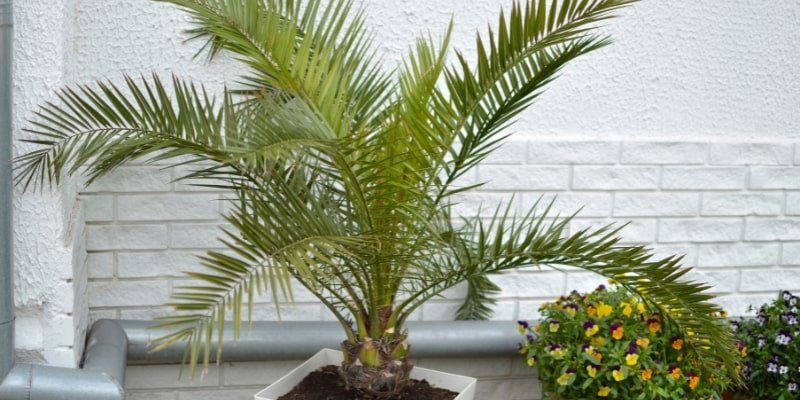
Scientific Name: Ravena rivularis
The Majesty Palm is an essential addition to any list of large-leafed indoor plants. One of the many common indoor palm trees is this lovely tropical plant. The graceful green fronds of majestic palms number in the hundreds. In any brightly lit corner, it creates a stunning impression.
The maximum height of a majestic palm is six feet, with an approximate yearly growth rate of one foot. In container gardening, they need soil that is wet, well-drained, and acidic. They also like temperatures between 65 and 85 degrees Fahrenheit and considerable humidity.
13. Snake Plant
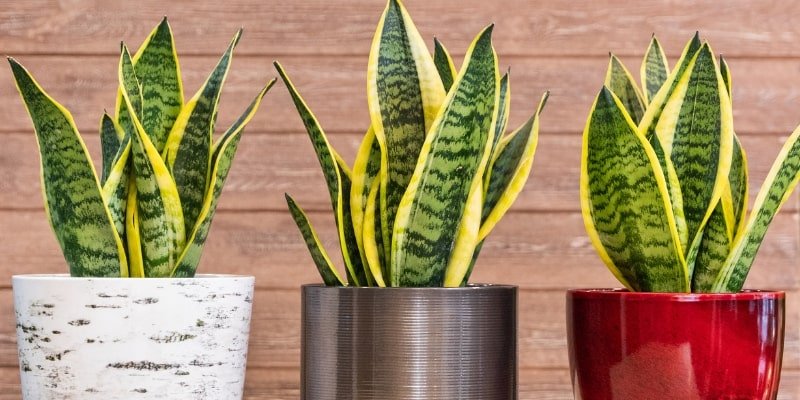
Scientific Name: Dracaena trifasciata
Plant Type: Evergreen perennial
Plant size: 8 feet tall
Sun needs: Indirect light to full shade
Water needs: Water every two weeks
Large leaves and easy maintenance make the snake plant a popular indoor plant. The plant has sword-like leaves that are rigid and pointed upward. Though popular variations feature a yellow or white border and a dark green centre, they vary in colour.
Low light levels are ideal for tropical plants like snake plants. Because of this, they are a fantastic complement to basements and halls.
14. Calathea Orbifolia

Scientific Name: Goeppertia orbifolia
Plant type: Tropical, perennial
Plant size: 3 feet tall
Sun needs: Semi-shade
Water needs: Once the upper inch of soil has dried, apply filtered water
One calathea cultivar that is well-known for its big, gently rounded leaves with pale, whitish-green stripes is Calathea orbifolia. The leaves are silvery-green on the underside.
Numerous calathea variants exist. Because of the way their foliage rises and falls in response to the sun, they are often called prayer plants. These tropical plants are native to Brazil; to prevent brown tips, they need high humidity and fertilizer that is heavy in nitrogen.
15. Monstera
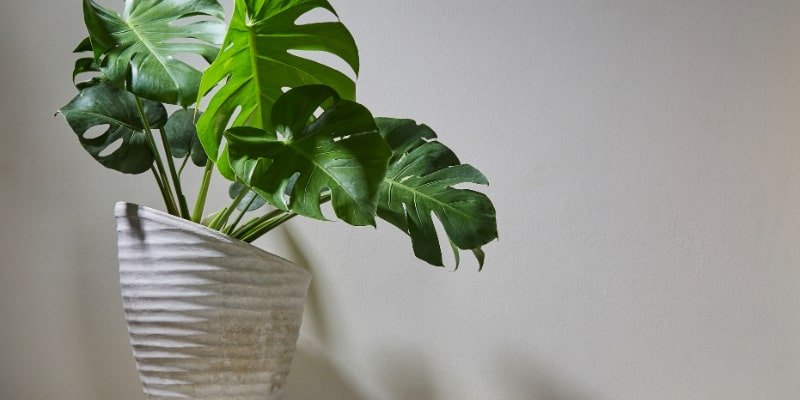
Scientific Name: Monstera deliciosa
Plant type: Climbing evergreen
Plant size: 3 feet in height and 3 feet in width
Sun needs: Brilliant indirect light is somewhat obscured.
Water needs: Water every 1-2 weeks and let it dry out between watering
In the world of plants, monsteras are a favourite. Their big, eye-catching green leaves are heart-shaped and contain distinctive leaf splits known as fenestrations. With the right assistance, they can spread out like a vine.
Ensuring enough drainage for monsteras in both their soil and container is crucial. This plant detests wet roots more than anything else. Warm weather and steady light are also necessary, though too much direct sunlight might scorch the leaves. To assist the plant in maintaining the right humidity, mist it frequently.
Conclusion
Huge, leafy indoor plants are a lovely way to breathe new life and refinement into your home’s design. To find out which plants are ideal for your house and climate, it is advised that you consult with a nearby nursery.
But any of these gorgeous indoor plants can be given the attention they require to flourish if you have a little perseverance, practice, and research skills.

